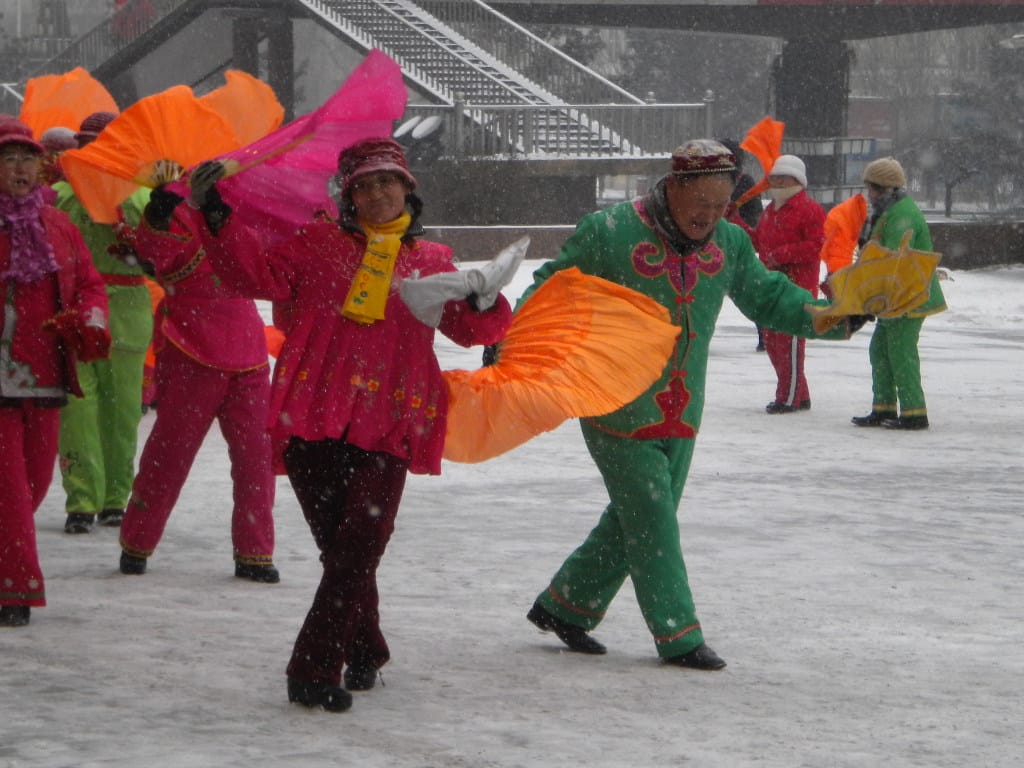Even before I’d heard of the Eurovision Song Contest I’d hold its dance equivalent in my bedroom before tea on Sunday afternoons. Dressing my nine year old self in a weird combination of clothes, “Maria from Italy” or “Tatiana representing Russia” would prance around the room performing what I imagined was the national dance of those countries until my mother called me for boiled eggs and toast. Since then I’ve been fascinated by the cultural dances of the world, so it was inevitable that I would take salsa dance classes while living in Huhehaote, capital city of Inner Mongolia, China.
It took a while to find the Love Sport Gym, located as it is among the food court of the Hailiang Shopping Plaza. Perhaps they hope to attract guilty over-indulgers. Finally I found it, lodged between the noodle soup place and a posh restaurant serving brown slimy things from the sea. Tiger Wang, the sales manager, was most helpful and before I knew it I had parted with several thousand yuan for sixteen months membership of the smartest sports club in town. The dance class schedule was exciting; belly dance on Tuesdays and Thursdays, Latin on Saturdays and best of all, Mongolian on Sunday afternoons.
Now, I don’t want to give the impression that I’m any good at dance, just because I’ve attempted various stylizations such as flamenco, salsa, Greek circle dancing and a little bollywood (I’ve also learned basic Arabic drumming). I just enjoy the rhythms and the movements and the insight gained into that culture. I don’t relish going to the gym but taking a dance class after a boring workout gives me the impetus I need. It’s a good way to make new friends too, even if we’re still on smiling and nodding terms. I can also count to eight in Chinese.
For Chinese people, taking a dance class is all about exercise and discipline. Classes for the interested amateur are serious business. Learning the steps and performing them correctly is the goal, any actual fun had in the process is secondary. The Latin dance class is a good example. Our teacher is a tall, lean woman in a short black skirt and grey leggings and an animal print top. She stares belligerently at us, lecturing us and stopping the music at each error for further correction. The students stand in military rows. There are no men and absolutely no partnering up. We learn two steps in the whole hour.
It is not fun.
Not speaking Chinese, I leave each class with a cricked neck from straining to see the teacher. I am always two beats behind. With the exception of a couple of other ’40-something’ ladies, most students are flexible young girls in their twenties. ‘Tatiana from Russia’ is nowhere to be seen as I strive to keep upper body stiff, my legs straight and my wide western hips under control in a very stiff, rather forced form of Latin dance.

I asked a friend to help me speak to the teacher after the class. ‘So, where do people go in Huhehaote to dance salsa socially? I mean, for fun? You know, practice the steps we have learned?’
A lengthy and heated conversation takes place between the teacher and my interpreter who finally turns to me and says, ‘There isn’t’.
‘But what did she actually say?’
‘There is nowhere you can go. Well, maybe there are some dance halls but these are for people of…bad reputation…it could be dangerous for you…’
‘I don’t mind! I don’t want to talk to them. I just want to dance with them!’
It was hopeless. People in Huhehaote do not dance for pleasure.
On a trip to the city of Guangzhou in southern Guangdong province I spent a morning walking the shady boulevards of Yue Xiu Park. Turning a corner, Latin rhythms drew me up the hill. My heart skipped a beat. Salsa! A group of ladies (and some gentlemen) were dancing together and taking it very seriously. Faces expressed concentration, limbs moved with precision; there was little eye contact between the dancers. This was not dancing from the heart, it was dancing for the heart, like aerobics. Like so many things in China this activity was for self-improvement, keep-fit for the elderly.

Nonetheless I joined a congo line doing the rabbit dance, the simple repetitive steps mimicking the catchy tune. It was fun. We laughed at the silly dance, even if it wasn’t salsa.

